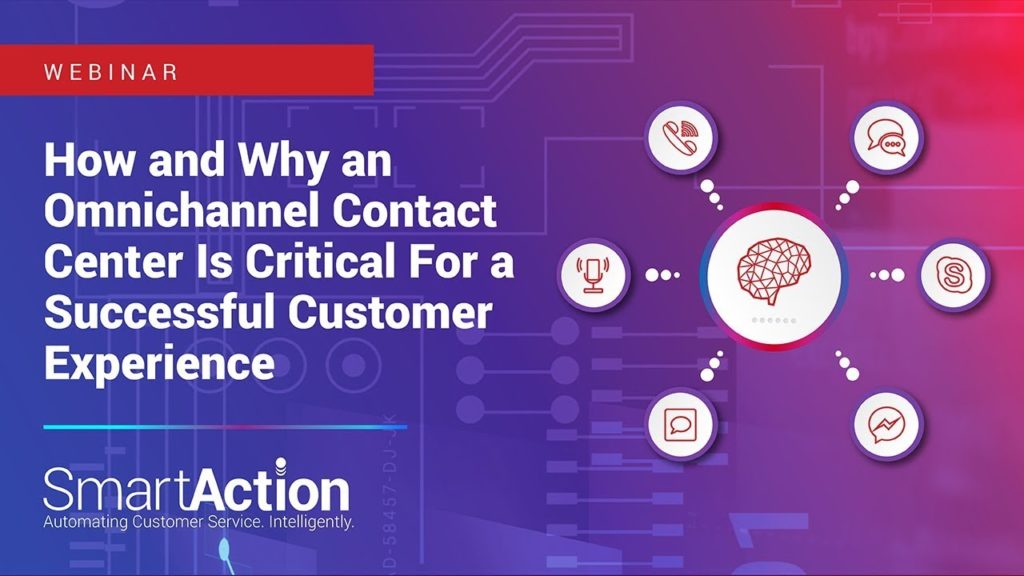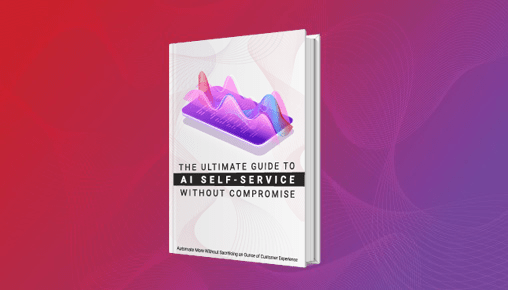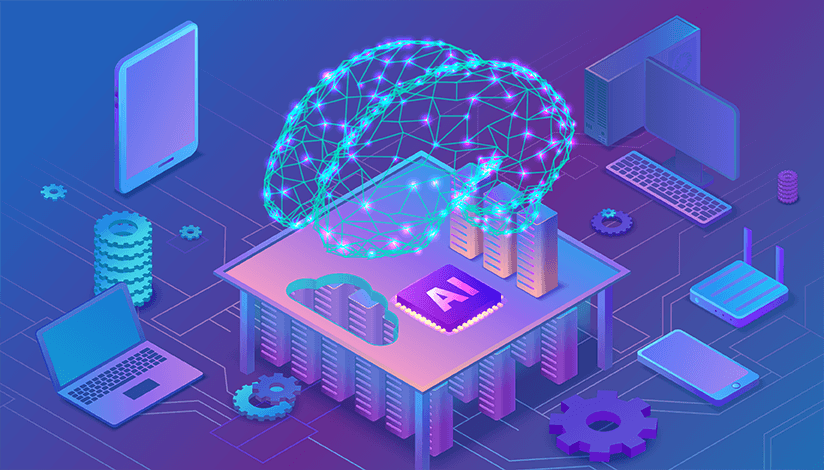Why an Omnichannel Contact Center is Critical For a Successful Customer Experience

Watch This
Webinar

Tom Lewis
CEO,
SmartAction

Charlie Schrier
Director of Marketing,
SmartAction
Why an Omnichannel Contact Center is Critical For a Successful Customer Experience
On-Demand Webinar
Kim: Hello everyone and welcome to today’s webinar, “How and Why an Omnichannel Contact Center is Critical for a Successful Customer Experience.” This is Kim and I’m your moderator today. We’ll get started in a few minutes, but I want to get some housekeeping items out of the way first.
So, first things first, this webinar is being recorded and you will get a link to the recording a couple days after the event, so you can look forward to that. And there was a chat icon at the top of your screen. If you have any questions throughout the presentation, send them over to me and I’ll direct them to the presenters. We are doing a little bit of a different format today, so, more of a conversational, Q&A-type webinar presentation. I will perhaps even send the questions directly to the presenters throughout the presentation if I have a second to step in and if it makes sense for the questions. Please continually send those over throughout the presentation, otherwise, I’ll just address them to the speakers at the end of the event.
And now, I’m going to introduce my speakers and then I will hand it over to them to get started. First, we have Tom Lewis. He’s the CEO of SmartAction. He’s been on many of my webinars and he’s our subject matter expert. He has over 28 years of experience in this space and formerly led the Deloitte call center advisory practice. He has a ton of knowledge in multiple areas, particularly, contact center, omnichannel strategy and, of course, artificial intelligence.
Second, we have Charlie Schrier who will be facilitating the conversation and adding in his own insight. He’s our director of marketing and is an expert in identifying market trends. He manages our analyst relations, so he has a ton of information on what’s going on in the industry and he uses it to create the content that we’re pushing out over here at SmartAction. Now that that’s out of the way, welcome to my speakers and I will send it over to Charlie.
Charlie: Great. Thanks so much, Kim, and welcome everyone. Welcome, Tom. I’m really excited to talk to you today and pick your brain a little bit about omnichannel call center, artificial intelligence, and some of the big things that are happening out there. This should be a fun conversation. So, why don’t we jump right in?
The first question I have revolves around customer expectations. We know with so many of the new consumer technologies that are out there, and we’ve talked about this on several occasions, that there are lots of changes to the way customers are experiencing the world. What are the customer expectations these days and what does that mean for communication strategy for brands?
Tom: I think the introduction of Google Home and Amazon Alexa, and so forth, has changed the dynamic in the consumer’s mind, which is interesting because simultaneously, it’s also changing the business buyer’s mind. They’re realizing that their consumers are getting used to interfacing with this very capable technology using their voice. And not in every instance, but in a lot of cases, voice is, and should be, the best communication channel from a human to machine kind of conversation, if only the machine could understand it.
Now, people are getting used to the fact that there are some limitations still in any of the technologies I just mentioned, including in SmartAction, etc., but it is evolving more and more in terms of what it can understand. I think consumer expectation is the main driver here. I think businesses are driven more today by customer experience than they were five years ago, which is really all-around cost and the fascinating thing is that if you drive customer experience, you actually get cost-savings at the same time.
Charlie: Let me go back to something that you said about voice being the easiest interface. I know I’m guilty of not making phone calls or not doing some of the things through voice that oftentimes we do with Alexa. I have an Alexa in my house and I probably don’t take full advantage of it. Can you defend that point a little bit because I text more than I would probably call or use voice?
Tom: I would say it’s all right. It doesn’t need a defense because the fact of the matter is, the consumer approaches the conversation with “I want to interface with you, the brand, in whatever way is going to be the most efficient for me.” If I want to have a text conversation with the company or if I want to have a voice conversation or do it on the web, we are now at a point where you should be able to have all of those platforms and let the consumer decide. We’ve talked many times about the book that came out five years ago or so, called, “The Effortless Experience.” In “The Effortless Experience,” there’s lots of doctrine in there, but one thing that I like to hang my hat on a little bit is the notion that customers will choose to interface with you through whatever channel is the easiest for them to get the task done. So, if they think it’s calling, picking up the phone, that’s what they’re going to do. They can bark at their personal assistants, then that’s what they’re going to do and everything in between.
Charlie: Right, I agree. That actually kind of leads a little bit into the conversation around omnichannel. Omnichannel is one of those buzzwords that’s been on everyone’s slides and everyone’s topics or events, and all kinds of marketing for so many years. What does it really mean? What is the true omnichannel environment?
Tom: It’s funny that we’ve been talking about this for five years and that we’re having the conversation. That’s a perfectly valid question because people are still asking, “What does it mean?” And part of the reason they’re asking…so, before I answer, let’s go down to: why is this still a question? It’s because it’s a little bit of a holy grail. There are technology enablement things in a call center that can enable an omnichannel conversation, but there’s also the human factor. And what I mean by that is not necessarily the caller or the consumer, but enabling the humans inside of an enterprise to be able to interface with all the different channels could have been the source of the conversation.
Charlie: Can you give me an example of that?
Tom: Yeah. So, for example, if you have a chat and you want to enable chat as one of the channels, having chat agents is different than having call center agents. The staffing is different, the training is different, and so forth. Everybody knows this if you’re running a call center, but what it means is that to achieve true omnichannel, it can be more difficult than just the technology.
To answer your question directly around what is omnichannel, you first have to understand multichannel. Multi-channel is simply the notion that your operation is set up to accept input conversations from callers, consumers, members, through various channels and whether that’s through SMS text messaging, chat, through email, potentially, through fax and through the phone, through IVR, etc. These are all the multichannel paths into your operation. If you have Ouija boards, fine, then that can be another channel down the street.
Charlie: It could be a new channel.
Tom: It could be a new channel, not as effective, not as cost-efficient, and so, omnichannel, the next layer on that is the ability to sort of go what I refer to as intermodal. You start in one place, the best example of this is starting in the website. You’re looking for the answer. You’re looking for something, and you determine that you need to then go to another call because you’re not getting the answer or chat. Being able to pick up where you left off from the web and have the agent or whatever is coming next understand the breadcrumbs that you’ve left behind in terms of looking something up. So, for example, if you’re looking at your last invoice and then you determine that you want to call, the call center should know that you are on the web looking at the invoice and start the conversation, “Are you calling about the most recent invoice or something along those lines?”
So, there’s some hooks and tricks in these ways to make all of that integrate. What’s interesting is the technology is probably farther ahead of this entire conversation than the adoption. And the adoption isn’t just the adoption with the consumer, the adoptions in the call center or the contact center, I should say, in terms of, are we ready to integrate all of these different channels?
Charlie: Yeah. I think of the consumer, too. Probably, you wouldn’t even notice it, in fact it might even feel really effortless exactly in the way that you were talking about and you might all of a sudden just think, “Wow, that was quite easier than I expected.” But can you maybe give the best example of what you’ve seen out there today in terms of adoption of how you gave the invoice example? Have you seen somebody doing that out there today?
Tom: Yeah, I think when you, and there are several ways to do it from a web-to-phone interface and that can either be, you’re calling a specific phone number and so that means that you were and got that phone number probably off the billing phase. That’s the simplest, low-tech way to do it. The other is essentially giving a serial number that you can enter in on the phone and that links the two together. Or if you’re authenticating on the phone, then it should have all that data for you. So, there are sort of three different ways to do that.
I think also for our roadside assistance business, for example, when we need to identify where somebody is, we send them a text message and while they’re on the phone or immediately afterwards. They’re engaging with the system to try to identify specifically where they are. That’s an intermodal conversation, a transition from the voice to the text. I think that’s a pretty simple example. And then the reverse is true, too. If you’re in a chat session or you’re in an SMS session and needing to talk to somebody via voice, we can call you back or the systems can call you back. Keep in mind, too, I think the best practice in this case is that if you’re in the particular channel, that you’re using automation like a bot, then you need to go to a human for more attention. Still, it should probably be in that same channel and only then when that fails, then go to, let’s say, a voice channel or something like that.
Charlie: Right. And so, let’s talk about how the agents are involved a little bit on that and one of the best practices that we’ve talked about is sort of passing a lot of that data. That happens in the bot conversations. How can company set themselves for success in that regard because I think that the agent kind of fits in with that omnichannel approach as well and they’re actually one of the channels? You might even consider themselves. How do they get all that information? What’s the best practice there?
Tom: Yeah and I think that is probably the tallest pole attempt as they say, in terms of really deploying a good, slick, customer experience-focused engagement because if you don’t have the data, then as many have heard me say before, it’s sort of, like, Dory from, “Finding Nemo.” If you’ve seen the movie, every time she’s met you, it was the very first time she’s ever met you and that’s how a lot of IVRs are designed.
But imagine your health plan, for example, and we just sent out an explanation of benefits and based on the timing of that, we are calling four or five days later. Chances are good if no other activities going on in your account, but that’s probably why you’re calling. And so, if you start the conversation with, “Hi,” once they’ve authenticated, “Hi, Bob. Are you calling about that explanation of benefits we sent you last week or something else?”
And so, even if the caller isn’t calling about that, and they did get an explanation of benefits in the mail recently, it says, “Okay. Wait, well, hang on a second, this thing may actually have more data and more insight about who I am and create a richer, and then more engaging.” And frankly, if one of the organization’s goal is containment and I mean that in a good way. Containment can have, sort of, a negative connotation based on that’s how IVR hell got created and IVR gel or whatever you want to call it, but this is good containment where I want to engage with this thing because, frankly, if it’s got the data, then that’s good. So, your question was around how the organizations get that?
Charlie: Yeah and then how can you state the organization set themselves up for success when they want to do that? So, they’ve got the data, but how can they sort of setup some of those connections and do some of the training around, making sure their agents are prepared and able to access of that?
Tom: Well, maybe I see that as two questions. One is really around the data itself and one thing to do is envision the user-experience that you want, what data would you need in order to envision that experience. And so, the example I gave was around an explanation of benefits, so you can imagine that in terms of understanding the…and I’ll use the word breadcrumb trail trails again that the consumer is leaving behind in their account and using that as input into the conversation. You envisioned the user experience you want and then you enable that data. That’s easier said it done obviously because a lot of companies have very monolithic systems that weren’t necessarily designed with that in mind. So, creating web services, access to data in various method is a big piece of that.
The good news is that if the data is available on the web, you can also expose it to an IVR or to SMS, or whatever. SMS is a little bit trickier because it’s not a secure channel, but we can get into that later. And then as far as the agents are concerned, I think from a data perspective, a lot probably on a good exchange either through SMS or through voice, a lot of contents, and lot of contacts has passed by that the agent isn’t aware of yet. And so, when the agent gets it, the problem is that they could potentially be starting the conversation all over again. You certainly don’t want that.
And so, capturing the data during the exchanges with the automation and passing…maybe passing that data on specifically or passing on sort of what I’ll call, the framework or context of what happened on the call, what the objectives were, the goal of the call based on the caller saying, “Well, I want to check on this,” or, “I want to deposit this,” or whatever the conversation is and how many agents not having to reauthenticate. Very funny, I mean, we go in a lot of call centers which have perfectly functioning authentication processes and we listened to the agents, and the first thing we see is them reauthenticating the caller. And so, they’ve invested a lot of time and energy in the authentication process and to save money and make it easier for the caller, and yet, they are redoing that particular task again.
So, in terms of the data that the call center agent can use, some of that has pass through CTI data, Computer Telephony Integration and some of it is really dependent upon the systems that are call center systems or, sorry, ERP or CRM systems, and things like that. So, it’s a coordinated effort, but in my long-weighted answer. My short answer would be, imagine, envision the customer experience that you want and then design the dataflow after that.
Charlie: A hundred percent and that makes a ton sense. And one of the questions that we actually just got in from the viewers is that, it’s around data and how much do you feel is necessary in order to get started? And probably it’s one piece is better than zero, 50/50, etc., from there, but how much would you advise to, how much data do you need?
Tom: So, let me answer the question two ways. Broadly speaking, when you’re introducing technology into customer service, I think it’s perfectly acceptable if your vendor can do it is to sort of crawl, walk, run. And what I mean by that is start in an area where you think there’s fairly low risk, if you’re concerned about that, where you have, perhaps, limited resources, but enough impact that it will show benefit that will basically fund the next thing.
And so, when it comes to data, I would take this same approach, which is, initially, if the only data you can expose is that which will allow for authentication, then start there. And if you can get richer and richer data as time goes on, it should be sort of an agile methodology. There’s no reason why not to apply that methodology because whatever you can envision today, chances are that by the time you get end of that road map, you’re probably going to be envisioning a whole bunch other things and technology will advance, etc. So, just don’t think of it as project worth, think of it as an evolution, a journey. Think of it as, you start on the journey and then we have this, sort of, lofty goal to get to the perfect balance of automation and human interaction.
Charlie: Right, right, and that’s where it headed really is…
Tom: It is.
Charlie:…being able to work with and deal with both and use both in the best manner. So, with that in mind, from an omnichannel perspective, just to bring it back to that, what are some of the essential components of an omnichannel strategy from a contact center perspective?
Tom: Well, I would start with the human piece and the human piece is sort of bifurcated into what your capabilities, and broad capabilities and best practices from your agent perspective and what the demand is likely to be from the human aspect of your customers. So, you have both of those sorts of competing demands and you may determine that internally. It’s just not practical to use a particular channel or to have…let’s just not back to my journey statement. It’s just not feasible for us to do chat right now. We’re going to stick with the phone channel and we’re going to push a bunch of people to the web and maybe the IVR, and that’s in so we got to chat next.
Understanding human dynamic is key both sides of that human dynamic. Beyond that, the technology, I think there’s two pieces to it. One is, how you stitch it all together and some vendors have one of everything, which is great, and you can sort of put that together through one vendor. Generally speaking, a one-vendor solution from everything from your PBX to your IVR, to your chat, whatever, probably means some of those channels are not best of breed. And so, you have to determine, where are they going in terms of the ability to get to a best of breed capability? For the IVR, for example, are they 100% natural language throughout the entire conversation? Do they have a complex natural language understanding capability to the interfaces, and so forth, and so on, and there’s a long list of things?
Charlie: What’s the cost look like? I was just having a conversation with an end-user the other day and it was to upgrade all of that stuff to get some of those pieces. The cost was just astronomical. It didn’t work for their business.
Tom: Well, the cost piece is definitely total cost of ownership and then upfront cost as well. There’s a lot of interesting technology coming out in the marketplace whether you’re looking in Amazon Lex or you’re looking at IBM Watson. These are fantastic technologies. There’s no question about it, but how much time, effort, cost, etc.?
And so, I think having a, really, realistic assessment of what the skills required to pull it off. In fact, one of the things I would say is back to my consulting days, I would often have this discussion around, well, should we do it ourselves? Do we buy versus build? Do we outsource it? On the human side of outsourcing, too, and a third party outsource is very simple conversation and the same actually applies to a lot of technology outsourcing.
And so, you ask three questions. And the first question is, do we have the core competency in-house right now to do this particular thing, whatever it is? Number two is, does doing it ourselves create a differentiation on the marketplace that is truly one of a kind, that we really need to do it because there’s no way we can get exactly the product that we want by outsourcing? And the third is the point that you just made which is the cost piece. Can we do this more economically ourselves?
And if the answer to those three questions is, no, then this is an outsourcing opportunity. When I talked about natural language, understanding 100% natural language, AI, some of those things, those are the skillsets that, retail establishment or health plan, they could setup whole departments in AI and all that kind of stuff, but there are businesses like ours and businesses out there that focus on these things and the point when you can’t answer yes to those three questions, and those are probably an outsourcing opportunity.
Charlie: Right, right, and on these same lines, another question that came in from the viewers is around how do you prioritize which channel to perfect versus which ones to push customers do as a new channel for them?
Tom: Well, I think the aspirations of the businesses are that everybody’s talking about omnichannel and customer experience and customers…and everything I said at the beginning of this dialogue with you was around customers choosing the channel that will have the least amount effort. So, all of that makes sense, but it’s undeniable that voice is still a huge part of the main channel in many, many organizations and it’s not going away anytime soon in those organizations. In fact, they often tell the story about how the mid ’90s, CTI was the sort of new thing and now that if you didn’t have it in a couple of years, you were going to be way behind and we still go into probably 50% to 80% of the call centers we go into and they still don’t have screen pops and other things that enabling CTI.
So, from a, where do I start, I would say, again, agile methodology across multiple channels is wise, but don’t sacrifice your investments and your advancements in the voice channel. Voice meaning both the IVR to preempt, and to sort of streamline the call, that then get forwarded on to an agent and making sure that your agent delivery is still exceptional. The last point I’ll make on this is that I think Gartner has come out and said that by 2020, we start to see sort of their receding of the scale of call centers. I’ve been predicting this probably since 2013 that…
Charlie: [Inaudible 00:22:55].
Tom: Yeah, exactly. So, it’s not that call centers are going away, it’s that the growth of them from a human perspective is going to plateau around 2020, but there’s a lot of runway pass that, where you still going to have human and whether that’s on the chat side or on the pure agent side. Now, I’m not poopooing technology. Obviously, I run a technology company, and I’m a have huge advocate for it, but I’m also, a realist and a pragmatist. And I think from my consulting days, I understand that the realities of running a call center is I still get up and answer the phones. And so, if I can migrate to these other channels, certainly do that.
I think there are companies that have created, let’s say, Amazon Alexa apps and it’s really cool, but the adoption rate is so low. The question is, why you’re doing it? Are you doing to be a leader in that? Fantastic, then keep doing that. If you’re doing it because you think legitimately that’s going to siphon off a whole bunch of your volume, again, be pragmatic about it.
Charlie: Right and actually along those same lines, I think that the skill for Alexa or…it’s very similar to the app explosion in mobile phones, in the iPhones, Android and its cousin, and it gets it update if that’s the experience. The experience has to be the app, right?
Tom: That’s right.
Charlie: It can’t be you got to use the app to do it from other different experience and I think that it’s same with the skill. So, let’s go back to omnichannel a little bit. I mean, that’s why people are on the webinar, firstly. And was also include a newer buzzword, one that everybody is talking about these days which I bet you can guess, AI.
Tom: What’s that stand for?
Charlie: It stands for artificial intelligence as far as I remember.
Tom: All right, got it.
Charlie: Well, let’s talk about what’s AI, how AI and omnichannel can work together, and what are the components? Actually, let me back up. What are the components of AI and how do you view artificial intelligence? And then we can work our way into how you work it into the omnichannel?
Tom: And obviously, we could spend an hour or two, or a day or two, or a week or two on what is AI and how to optimize it. It is definitely a buzzword. I mean, there’s lots of different ways to think about it. Now, as you well know, and many of our listeners know that SmartAction actually started as an AI research company, but far before the founder even knew how to spell call centers or IVR. And so, we fashion ourselves as being pretty competent in the AI frame, but the fact of the matter is there’s also this corollary that is expressions like, “If it worked, it’s not AI.”
And my best example of that is when you think about the Russian chess champion in late ’90s that lost to IBM Deep Blue in a chess game. People said that’s amazing AI and you and I would look at that today and say, “Well, it’s a chess program. It’s not AI.” And I think that the goal line around where AI is and what it can be, and expectations around it is constantly moving forward because the capabilities that are introduced, it’s just computer software and it’s just question of, how much intelligence it’s using?
So, for example, you look at autonomous driving car and it learned where the lines are on the road and it pattern recognizes that. And it learns when… can drivers correct themselves and they’re like, “Okay, maybe that’s a spot that I need to be cautious about,” or things like that, or in the call center arena, identifying callers that are potentially calling a lot and why is that, and it’s a lot of patterns. If you look at, I don’t know, Facebook or Google, they can tell you which pictures are pictures of dogs, and some of that is because it had supervised learning. So, you have humans educates like, that’s a dog, that’s not a dog, that’s a dog, etc., etc., and then the next phase is like, “Okay, is this a dog?” And you eventually teach it essentially how to figure these things out.
So, in the omnichannel realm, I think there are learnings like when I’m spelling phonetically and somebody uses something other than what we refer to as the NATO standard. The alpha, bravo, Charlie, whatever kind of thing as somebody says, “B,” as in “BOY.” Well, okay, “B,” as in “BOY” can be difficult because it sounds like T as in Toy to automation. So, you teach it how to distinguish between those things or to validate and to add letters to the dictionary.
So, that’s from a speech recognition standpoint. If you think about speech recognition, the entire notion of speech recognition is deep neural networks and the idea of learning from giving it lots and lots of recordings, and what we refer to is certified transcriptions from things like, “TED Talks,” and UN speeches, and things like that, to teach it how to understand the human language.
And so, if you build the right framework which we obviously think we have, then you can teach it Jamaican or Chinese, or anything else because it’s all the same processes. It’s the machine learning how to interpret the languages by feeding it data. You feed it the dog images, now it learns how to do all the rest of the images. We feed it the English language. We’ve taught it and perfected all of that in terms of the data input, and now we put certified recordings of these other languages and now suddenly you have a multi-lingual platform by which that’s natural language and using, again, the deep neural networks in the AI. So, maybe a longer question or answer than you were expecting, but I think the way in which AI is used and the way it’s going to evolve, you’re going to ask me this question two years from now and having evolved the answer from it because it keeps moving.
Charlie: Absolutely, absolutely, and let’s go back a little bit to how that works with automation in agents. And so, where do you see…now, you’ve predicted when the call center population of agents may start to go down a little bit, how do you see automation and agents working together specifically AI automation? What does that look like as we continue to move forward?
Tom: So, I think the automation is trying to make it so that the things that the agent is doing or the things that require human characteristics like empathy and compassion, and persuasion, and certain levels beyond critical thinking and things along those lines. And so, imagine a scenario…this is sort of what I refer to as the virtuous loop. Imagine a scenario where a call comes into the call center in the agent and not all agents, but for agents specifically trained to sort of, again, the supervised learning piece. Understand that the call that came in actually should have been handled completely through automation, let’s say. Okay.
And so, they’re now in a knowledge or data position or data worker essentially not just the customer service agent. And they should be able to provide input into that automation that says, “Hey, that particular pattern should be handled this way.” And so that as you keep iterating on that overtime, then you suddenly get to the point where the calls that really are being handled by the agents are one of two things either that collection of human characteristics I talked about or frankly, a human that just decided that it doesn’t matter what your automation is, I want to talk to somebody, which is perfectly fine. It depends on your brand promise and so forth, but…
So, the interplay is, really, the humans working themselves out of a job to some degree, which sounds bad, but think of it this way, I think today if I ask most call center managers what their biggest thing that they’re worried about, and they’d say, “Retention, I can’t keep the agents here. The job has just gotten to the point where it’s not the same job as it was before and it’s getting harder and harder.”
And so, if you’re working call center agents out of a job, well, it means that the ones that stay behind are ones that want to do that, that aren’t the retention problems and become experts and are your A players. So, it’s a good symbiotic relationship, I think. Particularly, given also, the volume and then sort of this plateau I talked about in 2020 is going to play a big piece in this. So, all of that combined is part of the evolution.
Charlie: Yeah, definitely and, as you said, a symbiotic relationship with automation helping agents and agents being able to view it as assistance and not as replacement necessarily, but then also turning around and helping the automation itself. So, the virtuous loop.
Tom: That’s right.
Charlie: So, one question that we got from the audience as well is around security. And the other hot topic of today is security with data falling between the cracks. So, can we touch on piece compliance of omnichannel and which options are compliant, which ones aren’t? And we’ve got a couple of minutes left, so if you just want to touch on it quickly.
Tom: Yeah, so, I think and frankly, it also reminds me for those who are listening around the pending launch of these GDPR, which is the security profiles for the European Union which starts on May 25th. So, I’m sure one of our follow-up calls webinars will be on that topic.
Charlie: That will be.
Tom: But relative to security given what’s been in the press lately, I mean, they’re spreading around data to your chatbot and to your IVR, and so forth. And now that they’re creating other data stores is a little bit daunting or dangerous and so to the extent. And this is generally what we practice is we access any kind of data that our customers have long enough to conduct the transaction and then in memory, essentially, and not stored on our systems.
And so, that helps a little bit, but that doesn’t answer the omnichannel piece of the question which is, we didn’t audit of all of our customers transactions and many of them involved PII, Personally Identified Information, and we tried to figure out which ones would be perfectly suited both for a text bot. And what we found was only about 10% of what we currently had now. It’s a little bit of skewed population because we think our customers have particularly intimate relationships with their callers and so it’s a little more complex from that. And the reason is you can’t do multi-channel, omnichannel in every channel for every type of calls. The text is not a secure enough channel to do that way. And so, I think making a practical assessment around what you can and can’t do.
So, and that, actually, leads you back to one of the questions you asked 20 minutes ago which was around the integration or what I called the intermodal. And so, if you’re having a conversation via texts and that caller is taking you down the path that you should not do over text like credit card processing or whatnot, then leading them to a secure website or a different…or even just calling them and say, “Okay, I’m going to call you and now through IVR, you can do the credit card process.”
So, it needs to be a thoughtful process. I’m sure that this security data, infrastructure, people and so forth will be involved at each client and think about it. But it’s not a straightforward as it sounds, but it’s also…you have the conversation and you look at the use cases and you make a determination.
Charlie: Right and as you mentioned, there are work around to create really effortless experiences in the channels that may not be secure for some of those payments or authentications, particularly on [00:34:37] and things like that.
Tom: Well, and actually, if I can interrupt?
Charlie: Sure.
Tom: So, even on the text channel, for example, if you have recurring payments, you don’t need to answer the credit card information. You got the credit card information in your data stores and so, the text message is, “Do you want to process the payment?” And you’re not providing anything other than authorization to do your monthly transaction.
Charlie: Right and that’s kind of where I was leading actually in that even if it’s not a credit card payment, it can even be the bank account on file. You don’t even need to send over those numbers. So, that’s good. So, we’re running right up against time. So, I want to give it back to Kim and allow her to wrap up, but I think this was a great conversation. There are few more questions from the audience that we weren’t able to get to today, but we’d love to be able to answer them and I think Kim had some information about how people can get their questions answered afterwards.
Tom: Great talk today.
Charlie: Yeah. Thanks so much, Tom. I really appreciate it. Back to you, Kim.
Kim: Thanks, guys. Yeah, so, as Charlie just mentioned, we did have a couple of questions that came in, but what I’ll probably do is have him directly respond, him or Tom, directly respond to those that were leftovers. So, I appreciate people sending me questions directly through the presentation and we kind of interfere so then so that put us right up against time. But right now, I have on the screen a couple of follow-up options for you. One, if you want to email info@smartaction.ai with any questions that weren’t presented on…weren’t sent to me during presentation, feel free to do that. It comes directly to me so I can get those answered for you.
Visit our website for more information and we have an infographic out right now that is about first steps for easing into the AI revolution which is how to get basically get started in bringing the first steps into…first steps in getting started of bringing AI into your contact center. And then, again, as I mentioned, you will get an email from me by the end of the week that we’ll have a recording link to this presentation and an invitation for April’s webinar as well. So, thank you guys all for attending and that covers it for today, and hopefully, we’ll see you next month.





